GUNAKAN SOFTWARE "RAPIDSHARE PREMIUM" YANG TELAH KAMI SEDIAKAN UNTUK MENDOWNLOAD SEMUA EBOOK KOMIK BATMAN DI BAWAH INI.
Batman is one of DC Comics’s most popular characters. He has featured in several ongoing serises as well as miniseries and graphic novels and plays a major role in many others.
Batman (originally referred to as the Bat-Man and still referred to at times as the Batman) is a fictional character, a comic book superhero co-created by artist Bob Kane and writer Bill Finger (although only Kane receives official credit) and published by DC Comics. The character made his first appearance in Detective Comics #27 (May 1939). Batman’s secret identity is Bruce Wayne, a wealthy industrialist, playboy, and philanthropist. Witnessing the murder of his parents as a child leads him to train himself to physical and intellectual perfection and don a bat-themed costume in order to fight crime. Batman operates in Gotham City, assisted by various supporting characters including his sidekick Robin and his butler Alfred Pennyworth, and fights an assortment of villains influenced by the characters’ roots in film and pulp magazines. Unlike most superheroes, he does not possess any superpowers; he makes use of intellect, detective skills, science and technology, wealth, physical prowess, and intimidation in his war on crime.
Batman became a popular character soon after his introduction, and eventually gained his own title, Batman. As the decades wore on, differing takes on the character emerged. The late 1960s Batman television series utilized a camp aesthetic associated with the character for years after the show ended. Various creators worked to return the character to his dark roots, culminating in the 1986 miniseries Batman: The Dark Knight Returns, by writer-artist Frank Miller. That and the success of director Tim Burton’s 1989 Batman motion picture helped reignite popular interest in the character. A cultural icon, Batman has been licensed and adapted into a variety of media, from radio to television and film, and appears on a variety of merchandise sold all over the world.
The first Batman story, “The Case of the Chemical Syndicate,” was published in Detective Comics #27 (May 1939). Finger said, “Batman was originally written in the style of the pulps”[14] and this influence was evident with Batman showing little remorse over killing or maiming criminals and was not above using firearms. Batman proved a hit character, and he received his own solo title in 1940, while continuing to star in Detective Comics. By that time, National was the top-selling and most influential publisher in the industry; Batman and the company’s other major hero, Superman, were the cornerstones of the company’s success.[15] The two characters were featured side-by-side as the stars of World’s Finest Comics, which was originally titled World’s Best Comics when it debuted in fall 1940. Creators including Jerry Robinson and Dick Sprang also worked on the strips during this period.
Over the course of the first few Batman strips elements were added to the character and Kane’s artistic depiction of Batman evolved. Kane noted within six issues he drew the character’s jaw more pronounced and lengthened the ears on the costume; “About a year later he was almost the full figure, my mature Batman,” Kane said.[16] Batman’s characteristic utility belt was introduced in Detective Comics #29 (July 1939), followed by the batarang and the first bat-themed vehicle in #31 (September 1939), and the character’s origin was revealed in #33 (November 1939). The early pulp-influenced portrayal of Batman started to soften in Detective Comics #38 in 1940 with the introduction of Robin, Batman’s kid sidekick.[17] Robin was introduced based on Finger’s suggestion Batman needed a “Watson” with whom Batman could talk.[18] Sales nearly doubled, despite Kane’s preference for a solo Batman, and it sparked a proliferation of “kid sidekicks.”[19] The first issue of Batman was notable not only for introducing two of
his most persistent antagonists, the Joker and Catwoman, but for one of the stories in the issue where Batman shoots some monstrous giants to death. That story prompted editor Whitney Ellsworth to issue a decree that the character could no longer kill or use a gun.[20] By 1942 the writers and artists behind the Batman comics had established most of the basic elements of the Batman mythos.[21] In the years following World War II, DC Comics “adopted a postwar editorial direction that increasingly de-emphasized social commentary in favor of lighthearted juvenile fantasy.” The impact of this editorial approach was evident in Batman comics of the postwar period; removed from the “bleak and menacing world” of the strips of the early 1940s, Batman was instead portrayed as a respectable citizen
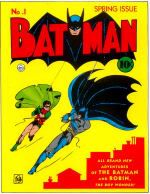
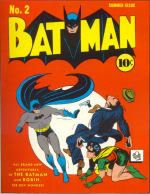
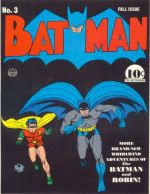
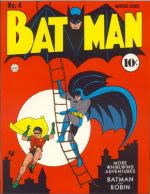


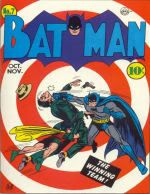
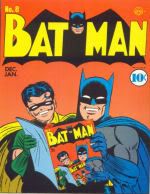

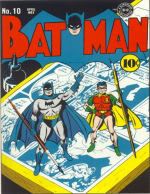










0 komentar:
Posting Komentar